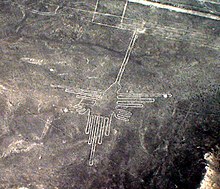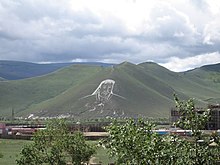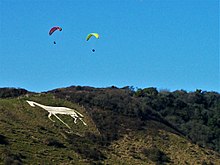What Ancient Works of Art Are Considered to Be Geoglyphs?

Geoglyphs on deforested country in the Amazon rainforest
A geoglyph is a large design or motif (mostly longer than 4 metres) produced on the ground by durable elements of the landscape, such as stones, stone fragments, gravel, or world. A positive geoglyph is formed by the arrangement and alignment of materials on the basis in a manner akin to petroforms, while a negative geoglyph is formed by removing part of the natural ground surface to create differently coloured or textured ground in a style akin to petroglyphs.
Geoglyphs are more often than not a type of state art, and sometimes rock art. A loma figure is created on a slope, then that information technology can be seen from a distance.
Ancient [edit]

Perhaps the most famous geoglyphs are the Nazca lines in Republic of peru. The cultural significance of these geoglyphs for their creators remains unclear, despite many hypotheses.[1] The "Works of the Onetime Men" in Arabia, "rock-congenital structures that are far more numerous than (the) Nazca Lines, far more extensive in the area that they embrace, and far older,"[two] have been described as geoglyphs by Amelia Sparavigna, a physics professor at Politecnico di Torino in Italy.[3] The use of this term to describe these features is probably inaccurate, as contempo research has shown that most were not constructed primarily every bit fine art, merely were rather built to serve a range of purposes including burial sites and funerary customs, aiding in the trapping of migratory animals, and equally cleared areas for camps, houses and animal enclosures.[4]

The Nazca Lines in Peru. This photograph taken in December 2006 depicts the hummingbird
Since the 1970s, numerous geoglyphs have been discovered on deforested land in the Amazon rainforest, Brazil, leading to claims about Pre-Columbian civilizations.[5] [six] [7] Ondemar Dias is accredited with commencement discovering the geoglyphs in 1977 and Alceu Ranzi with furthering their discovery after flight over Acre.[8] [ix]
Other areas with geoglyphs include Megaliths in the Urals, South Australia (Marree Man, which is non aboriginal, just rather a modern work of art, with mysterious origins), Western Australia and parts of the Great Basin Desert in the southwestern Usa. Hill figures, turf mazes and the rock-lined labyrinths of Scandinavia, Iceland, Lappland and the former Soviet Union are types of geoglyphs.
The south of England has a number of equine and man figures cut into chalk hillsides. Examples include the Uffington White Horse, Cerne Abbas Giant, Westbury White Horse, and the Long Homo of Wilmington. Some are aboriginal, others from the final few centuries.
More l geoglyphs are found in Kazakhstan.[10]
Contemporary [edit]

Bunjil geoglyph at the You lot Yangs, Lara, Australia, past Andrew Rogers. The creature has a wingspan of 100 metres and 1,500 tonnes of rock were used to construct it.
Not all geoglyphs are ancient. The Land Art motion created many new geoglyphs likewise every bit other structures; perhaps the most famous case is Spiral Jetty past Robert Smithson. Many towns and cities in the Western U.s. employ hillside letters (likewise known as "mountain monograms") on the hills above their locations. Contemporary Australian sculptor Andrew Rogers has created geoglyphs around the earth called "The Rhythms of Life". You Yangs Regional Park is the home of a geoglyph constructed by Rogers in recognition of the indigenous people of the surface area. It depicts Bunjil, a mythical creature in the culture of the local Wautharong Aboriginal people.[ citation needed ]

Geoglyphic texts and images are common in Cardinal and Inner Asia only at that place has been piddling systematic written report of their origins and spread.
More than recent figures in the south of England created since the early on 1800s take kept up the region's ancient tradition of chalk hillside figures. Examples of these are the Litlington White Horse, Devizes White Horse, Fovant Badges, Cherhill White Horse, and the Marlborough White Equus caballus.

In 2008–2009 Alfie Dennen created Britglyph, a locative art-focused geoglyph created by having participants across the U.k. go out rocks at highly specific locations and uploading media created at each location. When taken together and viewed on the main projection website an epitome of a sentry and chain inspired past John Harrison's marine chronometer H5 was created.[11]
People take used the Strava mobile app to create Strava fine art, virtual geoglyphs.
Geoglyphs in the world [edit]
| Country | Geoglyph |
|---|---|
| | Geoglyphs of Har Karkom[12] |
| | Uffington White Horse |
| Westbury White Equus caballus | |
| Cerne Abbas Giant | |
| Long Man of Wilmington | |
| Pewsey White Equus caballus | |
| Litlington White Equus caballus | |
| | Gila River Valley |
| Great Serpent Mound | |
| Blythe Intaglios | |
| | Nazca Lines |
| Paracas Candelabra | |
| | Acre Geoglyphs |
| | Atacama Giant |
| | Sajama Lines |
| | Marree Human being |
| Readymix logo geoglyph | |
| Bunjil Geoglyph | |
| | Great Indian Desert Lines, (likewise known as the Boha geoglyphs), Rajasthan |
Largest Geoglyph [edit]
In the Thar Desert of Rajasthan, India, researchers discovered the world'due south largest man-made sketch or geoglyph. It is larger than the Nazca Lines in Peru.
It is a massive spiral artwork in at Boha hamlet, close to Jaisalmer, that spans over 1,00,000 square metres. A sequence of geoglyphs were used to create the spiral artwork. Carlo and Uohann Oetheimer of France were the first to come across it on Google Globe.
The authors conducted field inquiry on the formations, close to Boha village. In that location, they found a succession of concentric and linear structures. These features were given the proper noun Boha geoglyphs, also known as the Great Indian Desert Lines. They estimate that the geoglyphs are around 150 years old.[13] [14]
Run across also [edit]
- Petroglyph
- Petrosomatoglyph
- Intaglio (burying mound)
- Battalion Park
References [edit]
- ^ New Technologies for Archæology: Multidisciplinary Investigations in Palpa and Nasca, Peru, Natural scientific discipline in archæology, page l, Markus Reindel, Günther A. Wagner, Springer Verlag, 2009. ISBN 978-3-540-87437-9
- ^ Professor David Kennedy, quoted by Owen Jarus, LiveScience Contributor. "Visible Merely From Above, Mystifying 'Nazca Lines' Discovered in Mideast", NBC News (via LiveScience), 9/15/2011
- ^ Amelia Sparavigna, quoted by Owen Jarus, LiveScience Contributor. "Visible Merely From To a higher place, Mystifying 'Nazca Lines' Discovered in Mideast", NBC News (via LiveScience), 9/15/2011
- ^ Kennedy, David (2011). "The "Works of the One-time Men" in Arabia: remote sensing in interior Arabia". Journal of Archaeological Science. 38 (12): 3185–3203. doi:x.1016/j.jas.2011.05.027.
- ^ Simon Romero (Jan 14, 2012). "Once Hidden by Woods, Carvings in Land Adjure to Amazon'south Lost Earth". The New York Times.
- ^ Amazon Jungle geoglyphs in Portuguese
- ^ Martti Pärssinen, Denise Schaan and Alceu Ranzi (2009). "Pre-Columbian geometric earthworks in the upper Purús: a complex society in western Amazonia". Antiquity. 83 (322): 1084–1095. doi:10.1017/s0003598x00099373.
- ^ Junior, Gonçalo (October 2008). "Amazonia lost and found". Pesquisa (ed.220). FAPESP. Archived from the original on 2014-08-12.
- ^ "Unnatural Histories – Amazon". BBC Four.
- ^ "Mysterious Ancient Geoglyphs Discovered In Republic of kazakhstan Leave Archeologists Perplexed". IFLScience.
- ^ Dennen, Alfie (2009-03-eleven). "Britglyph". Moblog. Archived from the original on 2008-12-18. Retrieved 2009-03-17 .
- ^ "The geoglyphs of Har Karkom (Negev, State of israel): classification and interpretation" (PDF). ccsp.information technology. Retrieved xxx July 2018.
- ^ Pacha, Aswathi (2021-06-03). "New geometrical lines discovered in Thar Desert". The Hindu. ISSN 0971-751X. Retrieved 2021-06-17 .
- ^ "Google Earth reveals the earth'due south largest geoglyph". California News Times. 2021-06-16. Retrieved 2021-06-17 .
Farther reading [edit]
- Tiffany May (nineteen Oct 2020). "two,000-Year-Old True cat Carving Found at Nazca Lines Site in Peru". The New York Times.
- Kennedy, David (2011). "The "Works of the Quondam Men" in Arabia: remote sensing in interior Arabia". Journal of Archaeological Science. 38 (12): 3185–3203. doi:10.1016/j.jas.2011.05.027.
External links [edit]
| | Look up geoglyph in Wiktionary, the free dictionary. |
- The Blythe Intaglios, A Photo Gallery
kingstongreste1991.blogspot.com
Source: https://en.wikipedia.org/wiki/Geoglyph